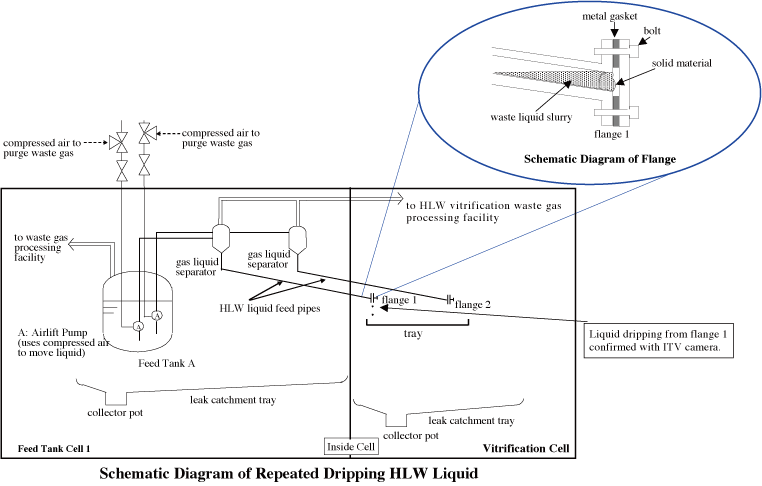Rokkasho Reprocessing Plant A never ending series of accidents Nuke Info Tokyo No. 130
This article provides an update on a report in Nuke Info Tokyo No.129 about a leak of high-level liquid waste (HLW) at the Rokkasho Reprocessing Plant.
The leak occurred in the HLW Vitrification Facility. HLW is transferred by an “airlift” system from a feed tank through feed pipes to the vitrification furnace, where it is mixed with molten glass. The vitrification furnace was not in operation at the time of the accident, but for some reason the air pressure rose, forcing HLW up the pipes. Due to a worker error, flanges were not properly closed and about 150 liters of HLW leaked from the pipes (see diagram below).
Japan Nuclear Fuel Ltd. (JNFL) delivered a report about the incident on April 10, 2009. In the report it admitted that more problems arose when it tried to clean out the contaminated cell. The leak occurred in the Vitrification Cell, but high-pressure cleaning liquid, contaminated with HLW, found its way through a gap where the feed pipe passes through the wall from the neighboring cell (Feed Tank Cell 1). As a result, elevated radioactivity was recorded in Feed Tank Cell 1 (0.7 Sv/h compared to the control target of 0.5 Sv/h). Furthermore, the power manipulator and crane in the Vitrification Cell would not work. It is believed that this problem resulted from corrosion caused by the nitric acid in the HLW which leaked and evaporated within the cell.
In response to these failures, the regulatory body, the Nuclear and Industrial Safety Agency (NISA), deemed that JNFL was in breach of the Reactor Regulation Law on five counts. The breaches identified by NISA included a slow response to alarms indicating a leak, and a failure to produce an operational plan, in according with safety regulations, about the method of detaching the feed pipes. It demanded that JNFL investigate the cause of the problems and introduce measures to prevent a recurrence. It also demanded that JNFL rectify organizational problems.
JNFL’s April 30 report, submitted in response to NISA’s demands, identified problems that call into question JNFL’s qualifications as a nuclear enterprise.
Problems identified in relation to the leak itself:
1) Preparedness to identify and manage leaks was inadequate.
2) Capacity for calm consideration of safety assurance was weakened by pressure caused by repeated extensions to the schedule for completion.
3) Insufficient staff were allocated, even though the work-load grew as a result of the frequent problems.
4) Inadequate attention was given to communication between senior and middle management and to seeking the opinions of on-site workers.
Problems identified in relation to the slow response:
5) An attitude of always considering the worst case was lacking, so even when liquid was noticed, it was not suspected to be radioactive waste.
6) Even though a worker noticed that the level in the Feed Tank had fallen, this was overlooked due to a lack of communication.
7) Some of the procedures necessary for detecting leaks were not specified.
Reading this report, one cannot help thinking of the huge leak discovered in May 2005 at the THORP reprocessing plant in the UK. BNFL, the owner of THORP, admitted that the leak continued for nine months without being discovered. Apparently the workers were prey to the false belief that such problems could not occur in a new plant. Perhaps the same could be said of the workers at the Rokkasho Reprocessing Plant. At Rokkasho too, JNFL’s workers made no preparations for the possibility of a leak.
On April 30, JNFL President, Isami Kojima, sent an email to all employees entitled “President’s Safety First Statement”. In it he appealed to them to “promise the public that you will never allow safety to deteriorate.” JNFL’s method of assuring safety seems to be to reinforce its employees’ faith in absolute safety. Incredibly, JNFL seems to be asking its workers to believe in the safety myth even more strongly than BNFL’s workers.
On January 30 this year the official date for completing active tests of the Rokkasho Reprocessing Plant (the final stage before the plant commences commercial operations) was postponed to August 2009. It was the sixteenth time the schedule had been postponed.
Masako Sawai (CNIC)

